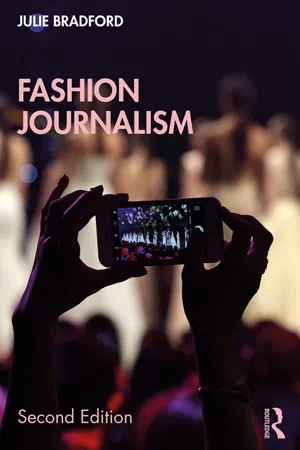
- 328 pages
- English
- ePUB (mobile friendly)
- Available on iOS & Android
Fashion Journalism
About this book
This comprehensively revised and updated second edition of Fashion Journalism examines the vast changes within the industry and asks what they mean for the status, practices, and values of journalism worldwide.
Providing first-hand guidance on how to report on fashion effectively and responsibly, this authoritative text covers everything from ideas generation to writing news and features, video production, podcasting, and styling, including advice on how to stay legally and ethically safe while doing so. The book takes in all types of fashion content – from journalism to branded content, and from individual content creation to editorial for fashion brands. It explores their common practices and priorities, while examining journalists' claim to special status compared to other content producers.
In conjunction with expanded theory and research, the book includes interviews with journalists, editors, bloggers, filmmakers, PRs, and brand content producers from the UK, the US, China, and the Middle East to offer all a student or trainee needs to know to excel in fashion journalism.
Frequently asked questions
- Essential is ideal for learners and professionals who enjoy exploring a wide range of subjects. Access the Essential Library with 800,000+ trusted titles and best-sellers across business, personal growth, and the humanities. Includes unlimited reading time and Standard Read Aloud voice.
- Complete: Perfect for advanced learners and researchers needing full, unrestricted access. Unlock 1.4M+ books across hundreds of subjects, including academic and specialized titles. The Complete Plan also includes advanced features like Premium Read Aloud and Research Assistant.
Please note we cannot support devices running on iOS 13 and Android 7 or earlier. Learn more about using the app.
Information
1 Introduction*
People were talking about the Supreme Court and women’s rights, and then out came these women wielding torches at Rick Owens and burned the place down. What an amazing message! What an amazing vehicle to show that message about women! All these conversations are happening, and fashion is part of this.(2018)
These customers that are coming to the website, sometimes more than 10 times in a single day, aren’t just looking for product – they’re looking for a deeper connection to the END. brand.So, to meet that need we provide what we consider high-value, publisher-standard content that can entertain them, inspire them, and inform them. The lines are blurring more and more. Retailers can be publishers. Publishers can become retailers. It’s a vertical integration of the chain in a sense.(2018)
The amount of opportunities that people have now to create content is fantastic. They’re influencers, they’re video makers, they’re photo-journalists, and they can be incredibly popular and professional. But these days they’re making money working for themselves. They don’t necessarily care about working with brands such as GQ and Esquire anymore … they can create their own brand and be successful on their own terms.(2019)
Journalism and ‘content’
Nowadays the challenge for the media is that everyone can be your competitor – anyone. Anyone can be a creator. We are not just competing with media, we are competing with celebrity itself. And games, and TV shows, everything. We are competing for time – who can get the readers’ time.(2019)
This is quite a mind shift for most journalists, who will be used to writing things that exist as part of a package of content. Online, you have to sell everything article by article, in the sense of finding an audience.(2019)
Having that editorial head and being able to simultaneously communicate a brand’s message – that’s such a brilliant skill to have. You can’t help thinking that this is the way things are going to head.(2018)
I did my first influencer project outside Vogue this year, with Nike. That was new. And it was kind of new for Vogue as well – there have been some editors who’ve done bits and bobs, but for it to come through to a junior member of staff, it felt quite new and the way that things are going.(2019)
Table of contents
- Cover
- Half Title
- Title Page
- Copyright Page
- Contents
- Contributor
- Acknowledgements
- 1 Introduction
- 2 Working in fashion journalism
- 3 Fashion media and audiences
- 4 The fashion industry
- 5 Ideas, sources, and interviewing
- 6 Writing fashion news and features
- 7 Reporting the catwalk
- 8 Reporting the trends
- 9 Digital and social media
- 10 Styling
- 11 Video and podcasting
- 12 Fashion bloggers and influencers
- 13 Fashion journalism and PR
- 14 Law and ethics
- 15 Conclusion
- Glossary
- Index